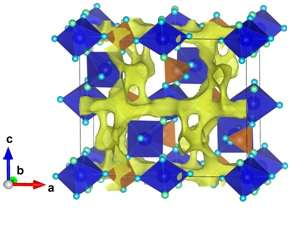Promising new cathode material to enhance battery life

Nowadays Li-ion batteries power a wide range of electronic devices: mobile phones, tablets, laptops. They became popular in 90s and subsequently ousted widespread nickel-metal hydride batteries.
However, Li-ion batteries suffer a number of disadvantages. For example, their capacity may drop when temperature falls below zero. The price is also inhibitory due to the use of expensive lithium-containing materials—for example, Li-ion batteries are responsible for about half of the cost of the electric Tesla Model S vehicle. However, Li-ion batteries are compact, easy to use and high capacity, offering long performance from relatively small batteries.
One limiting factor of Li-ion batteries is the cathode, as capacity limits for most cathode materials have been reached. Hence, scientists and engineers are actively searching for new cathode materials capable of recharging completely within minutes, operating under high current densities, and storing more energy.
One of the most promising candidates for next-generation cathode materials is fluoride-phosphates of transition metals.
The work, directed by Prof. Evgeny Antipov, was conducted by a team of MSU research scientists together with their Russian and Belgian colleagues. It was devoted to the creation of a new, high-power cathode material based on a fluoride-phosphate of vanadium and potassium for Li-ion batteries. The results were published in Chemistry of Materials.
"The work is based on a simple idea of geometric and crystal-chemical conformity of ionic sublattices," says Stanislav Fedotov, one of the authors, a junior research scientist at the Electrochemistry Department, Faculty of Chemistry, MSU.
The scientists stabilized a unique crystal structure that provides a fast transport of lithium ions through spatial cavities and channels. Consequently, the proposed cathode material demonstrated high charge/discharge rates (down to 90 seconds) retaining more than 75 percent of an initial specific capacity. With its morphology and composition optimized, this material may become a serious contender to such well-known and commercialized high-power cathode materials as NaSICON.
According to the authors, the results of the presented work may not only open up ample opportunities in searching and further synthesis of new cathode materials for Li-ion batteries, but also promote the development of a new battery type where a role of a mobile ion (a charge carrier) would be performed by potassium ions instead of lithium.
"It is assumed that such batteries would not only deliver high energy density, but would also be economically attractive due to a replacement of expensive lithium-containing components with cheaper and hence affordable potassium-containing analogues," explains Stanislav Fedotov.
More information: Stanislav S. Fedotov et al. AVPO F (A = Li, K): A 4 V Cathode Material for High-Power Rechargeable Batteries, Chemistry of Materials (2016). DOI: 10.1021/acs.chemmater.5b04065
Journal information: Chemistry of Materials
Provided by Lomonosov Moscow State University



















